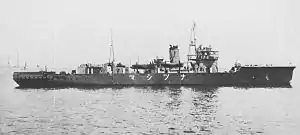Natsushima-class minelayer (1933)
The Natsushima-class minelayer (夏島型敷設艇,, Natsushima-gata Fusetsutei) was a class of minelayers of the Imperial Japanese Navy (IJN), serving during and after the 1930s through World War II. Their design was based on the Tsubame-class, but with increased armament.
 Natsushima in 1933. | |
| Class overview | |
|---|---|
| Name: | Natsushima-class minelayer |
| Builders: | |
| Operators: |
|
| Preceded by: | Tsubame-class |
| Succeeded by: | Sokuten-class |
| Subclasses: |
|
| Built: | 1931–1934 |
| In commission: | 1933–1944 |
| Planned: | 3 |
| Completed: | 3 |
| Lost: | 3 |
| General characteristics Natsushima-class | |
| Type: | Netlayer/Minelayer |
| Displacement: | 475.8 long tons (483 t) standard |
| Length: | 73.00 m (239 ft 6 in) overall |
| Beam: | 7.50 m (24 ft 7 in) |
| Draught: | 1.95 m (6 ft 5 in) |
| Propulsion: |
|
| Speed: | 19.0 knots (21.9 mph; 35.2 km/h) |
| Range: | 2,500 nmi (4,600 km) at 14 kn (16 mph; 26 km/h) |
| Complement: | 74 |
| Armament: |
|
| General characteristics Sarushima-class | |
| Type: | Netlayer/Minelayer |
| Displacement: | 566 long tons (575 t) standard |
| Length: | 73.00 m (239 ft 6 in) overall |
| Beam: | 7.49 m (24 ft 7 in) |
| Draught: | 2.02 m (6 ft 8 in) |
| Propulsion: | 2 × MAN Mk.2 Model 9 diesels, 2 shafts, 2,100 bhp |
| Speed: | 18.0 knots (20.7 mph; 33.3 km/h) |
| Range: | 4,639 nmi (8,591 km) at 14.4 kn (16.6 mph; 26.7 km/h) |
| Complement: | 64 |
| Armament: | same as Natsushima-class |
Ships in class
Natsushima-class
Project number H5. 3 vessels were planned under the Maru 1 Programme, however, 3rd ship Sarushima was used to diesel engine experiment ship.
Natsushima (夏島)
- 24 December 1931: Laid down at Tōkyō Ishikawajima Zōsen.
- 24 March 1933: Launched.
- 31 July 1933: Completed.
- In 1934: Rebuilding after the Tomozuru Incident.
- In 1938: Sortie for the Second Sino-Japanese War.
- 1941-1943: Sortie for the naval mine laying at Japan Mainland.
- 10 December 1943: Dispatched to southeast area.
- 22 February 1944: Sunk by USS Stanly, USS Charles Ausburne and USS Dyson off Kavieng 02°40′S 149°40′E.
- 30 April 1944: Removed from naval ship list.
Nasami (那沙美)
- 19 January 1933: Laid down at Harima Zōsen.
- 26 March 1934: Launched.
- 20 September 1934: Completed.
- In 1938: Sortie for the Second Sino-Japanese War.
- 1941-1943: Sortie for the naval mine laying at Japan Mainland and convoy escort operations at East China Sea.
- 31 December 1943: Dispatched to southeast area.
- 1 April 1944: Sunk by air raid at Rabaul.
- 10 April 1944: Removed from naval ship list.
Sarushima-class
Project number H5B. She was built as diesel engine experiment ship. Her results were made use of in the Sokuten-class.
Sarushima (猿島)
- 28 March 1933: Laid down at Mitsubishi, Yokohama shipyard.
- 16 December 1933: Launched.
- 20 July 1934: Completed.
- In 1938: Sortie for the Second Sino-Japanese War.
- 1941-1944: Sortie for the naval mine laying and convoy escort operations at Japan Mainland.
- 4 July 1944: Sunk by air raid off Otōto-jima.
- 10 September 1944: Removed from naval ship list.
Photos
 Nasami in 1934.
Nasami in 1934. Sarushima in 1942.
Sarushima in 1942.
Bibliography
- Ships of the World special issue Vol.45, "Escort Vessels of the Imperial Japanese Navy", "Kaijinsha"., (Tokyo, Japan), 1996.
- The Maru Special, Japanese Naval Vessels No.47, "Japanese naval mine warfare crafts", "Ushio Shobō". (Tokyo, Japan), 1981.
This article is issued from Wikipedia. The text is licensed under Creative Commons - Attribution - Sharealike. Additional terms may apply for the media files.